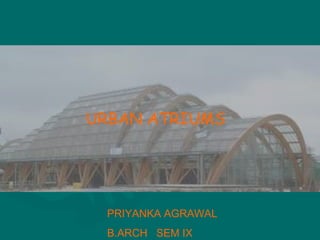Urban Plaza
- 1. PRIYANKA AGRAWAL B.ARCH SEM IX URBAN ATRIUMS
- 2. Urban atrium are public or semipublic pedestrian spaces partly or fully enclosed from the exterior climate. Atrium provides places for pedestrian, circulation, gathering and socialization, with many secondary purposes such as exhibition, dinning, retail and performance. Their unique urban design contribution is to create multipurpose gathering spaces, to foster pedestrian-friendly connection between streets, plazas, concourses and discrete building and to provide climate moderated environments for plants & for people.
- 3. True to its Latin derivative for âheartâ, atrium create central concourses and meeting places for urban life. Most often defined with large transparent enclosures that admit outdoor, light and air, they include galleries, exhibition halls, train shed, indoor markets and winter gardens.
- 4. Since the overhead enclosure is usually transparent, changes in daylight and season and the bioclimatic benefits are readily available i.e. the protected climate allows pedestrian to utilize atrium spaces and their amenities freely throughout the day and evening. Atriums add to the inventory of public spaces available to the pedestrian, joining inside and outside, and in hospitable climates, a continuous connection and extended urban experiences.
- 5. Atriums are also useful in creating access control for public, semipublic and private building users. The design of circulation is important to the success of atriums as public amenities. In this public access is limited to the street level, semipublic circulation is via bridges and tunnels, and private access is via high elevators. Pedestrian way passes trough the atrium Coordination between an atrium design and a significant urban pedestrian area.
- 6. Atrium space within an old building is carved by removing portions of each floor form top to bottom. the structural frames is left exposed to express the original framing method and the subsequent atrium formation. An advantage of the atrium concept is to enable restoration and protection of exterior of an historic building, which is used as part of an atrium enclosure, thus maintaining the urban fabric ,giving the building a new interior. Historic preservation and adaptive reuse Atrium design offers option in historic preservation, adaptive reuse, and integration of new with old structures.
- 7. The plaza atrium is not contained within a given building but exterior to and connected to them to interrelate several buildings by enclosing a large shared space. It can be varied in function and commonly intertwined with multileveled circulation systems. PLAZA ATRIUM
- 8. ARCADE & GALLERIA the arcade is a public space with hard pavement, a distinctive roof form, bright daylight and street furnishings.
- 9. WINTER GARDEN Motivation of winter garden was the enjoyment of nature as an art form-for its beauty and aesthetical appeal. These motivation combined with the development of iron structural members and glass.
- 10. DESIGN CRITERIA The spaces should be readily accessible from existing exterior places. this can be accomplished though direct physical linkage and/or visual transparency. Successful atrium spaces should be easily understood for purpose of way finding circulation and orientation. coherent spatial form and simple geometry will aid in achieving comprehensible circulations patterns. a strong spatial concept executed with consistent structural and architectural expression will aid in orientation. Atrium space should serves a public pedestrian purpose. They should contain pedestrian amenities and provide opportunities for socializing and public occasion. Technical requirements such as heating, ventilating and air conditioning, smoke exhaust, fire suppression and electric lighting should be integrated into a coherent architectonic expression that does not overwhelm the public spaces.










